Korean Temple Food
Barugongyang
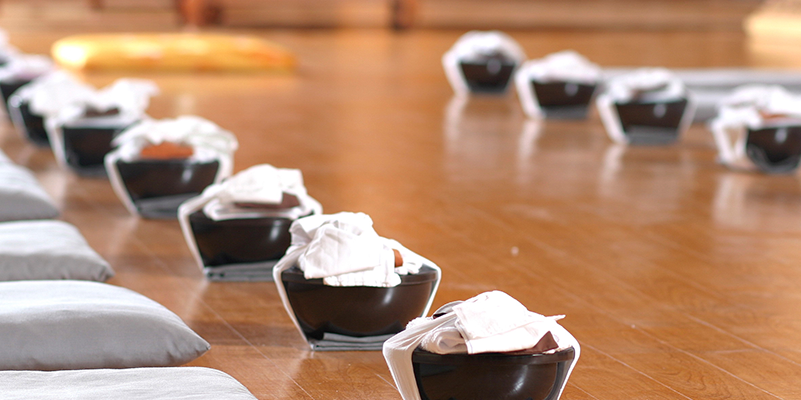
Barugongyang
Pre-meal ChantWhere has this food come from?
My virtues are so few that I am hardly worthy to receive it.
I will take it as medicine to get rid of greed in my mind and to
maintain my physical being in order to achieve enlightenment.
Rice, soup, side dish and water are each placed in a set of four bowls in different sizes.
Pairing just right amount of food from salty side dishes to go nicely with the rice can be a bit tricky to achieve.
One must carefully consider how much of rice and side dish to serve oneself so the right amount of both foods can be eaten till the end.
The key to baru-meal is taking only what one needs.
Baru-meal is one of the most environment-friendly ways of eating because it does not produce any left-over.
Even the water that everyone rinses off their baru bowls with is clean.
There is no room for bacteria to grow because the bowls are washed immediately after each meal.
The bowls and other utensils are disinfected under the sun on a regular basis which is more sanitary than using wet towels to dry excessive water.
Buddhist monastic meals are carried out in an orderly manner.
They are an important part of monastic practice.
The meaning contained in barugongyang is well represented in the verses chanted at each stage of the meal.
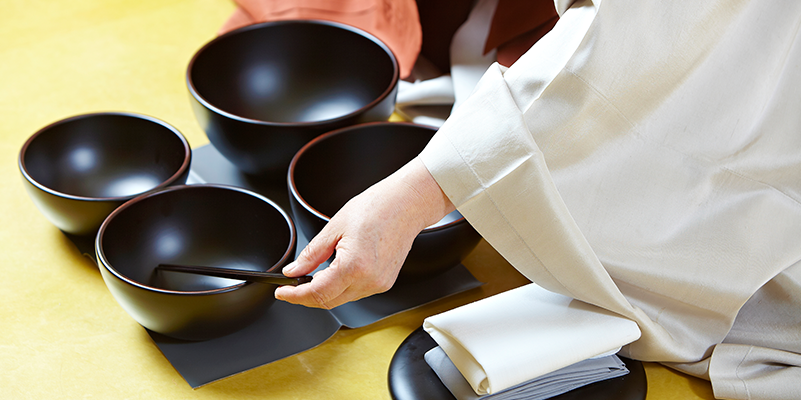
Baru
At that time, each of the four heavenly kings offered a stone bowl to the Buddha, from which the Buddha ate and then stacked together.
Following this example, disciples of the Buddha also began using four bowls for their meals, creating a tradition that is still practiced today.
During the formal monastic meal ceremonies at Korean Buddhist temples, a set of wooden bowls called baru are used to serve food.
The ceremony is named baru-meal or barugongyang after the bowls.
The bowls come in a set of four to five and each piece is slightly smaller than the previous one so that they can all fit into the biggest bowl for convenient storage and portability.
Eosibaru (or Buddha-baru) is the largest bowl exclusively reserved to hold rice and the second largest bowl is gook-baru (or Bodhisattva-baru) for soup.
They are followed by cheonsu-baru (or Sravaka-baru) along with banchan-baru (or Pratyeka-baru).
When there are five pieces of baru bowls, the smallest bowl is called shishikbaru and used to offer meals to beings in hell, hungry ghosts and asuras, but it is seldom used.
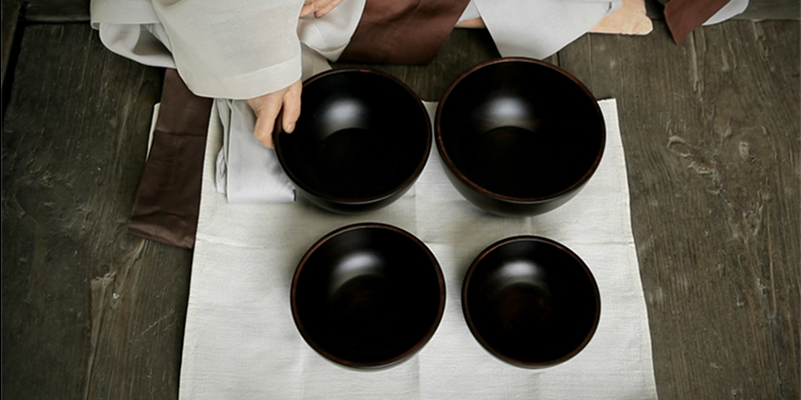
Normally Barugongyang spirit is spoken into 5 ways.
Equality
Regardless of one’s rank or status, all members of the community equally share and eat the same diet.
Cleanliness
Keeping one’s own baru bowls clean and only serving how much one can eat at once describes the definition of clean barugongyang. Monks gracefully go through the steps of baru-meal at the sound of bamboo clapper, like refreshing breeze blowing from the virgin forest in the mountain.
Honorable poverty
Once the food is served, even a tiny speck of seasoning cannot be left behind.
Individual should drink a small amount of water used to wash the inside of the bowl at the end of the meal.
Afterwards, used baru bowls are once again rinsed clean in a bowl of water called cheonsumul,
named after the Bodhisattva of Thousand Hands and her dharani,
because the water is so clean that it mirros the ceiling where the dharani is painted over.
Community
A sense of community is once again confirmed by enjoying the meals that were made in the same pot at the same time.
A Great Council meeting often follows barugongyang to discuss both big and small affairs around the temple in a democratic setting.
Virtuous deeds
A vow to accumulate merits is made when monks take a moment to express their
deep gratitude for the people whose hard work produced their meal.
Monks also vow to continue their commitment and dedication to save all beings.

Instructions for barugongyang
Instructions for Barugongyang
-
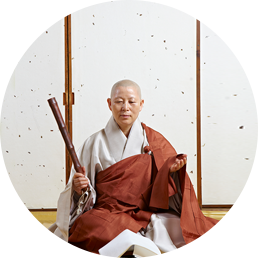 01.After the bamboo clapper is struck three times, join the palms in front of the chest and bow; then unwrap the baru bowls.
01.After the bamboo clapper is struck three times, join the palms in front of the chest and bow; then unwrap the baru bowls. -
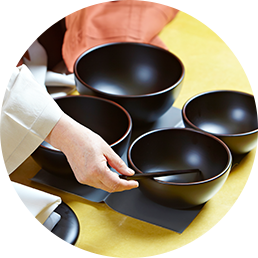 02.Arrange the four baru on the baru mat
02.Arrange the four baru on the baru mat -
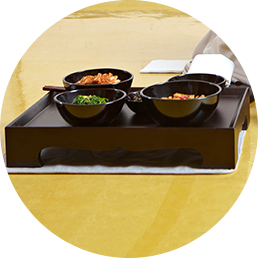 03.When the bamboo clapper is struck once, the assigned monks will pass the food in the following order: water, rice, soup, and assorted side dishes of vegetables and greens.
03.When the bamboo clapper is struck once, the assigned monks will pass the food in the following order: water, rice, soup, and assorted side dishes of vegetables and greens.
Rinse all the baru in the order of size with water that was initially served.
Save it in water-baru for later use. -
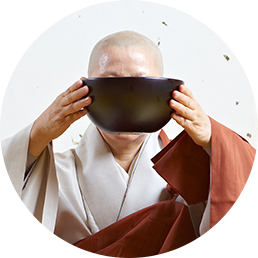 04.When the bamboo clapper is struck once again, hold and raise rice-baru high in the air with two hands and chant the “Meal Offering Verse."
04.When the bamboo clapper is struck once again, hold and raise rice-baru high in the air with two hands and chant the “Meal Offering Verse." -
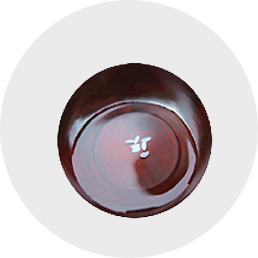 05.As a symbolic gesture of sharing food with all hungry beings, each monk sets aside a small portion of rice, which is gathered in a communal bowl.
05.As a symbolic gesture of sharing food with all hungry beings, each monk sets aside a small portion of rice, which is gathered in a communal bowl. -
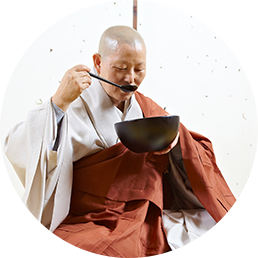 06.When the bamboo clapper is struck three times, eating finally begins.
06.When the bamboo clapper is struck three times, eating finally begins.
Practice harmonious eating by keeping pace with others and remain silent.
Leave a piece of kimchi to wipe any leftover food in the baru at the end. -
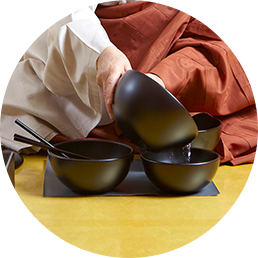 07.After the bamboo clapper is struck three times, join the palms in front of the chest and bow; then unwrap the baru bowls.
07.After the bamboo clapper is struck three times, join the palms in front of the chest and bow; then unwrap the baru bowls. -
 08.Arrange the four baru on the baru mat
08.Arrange the four baru on the baru mat -
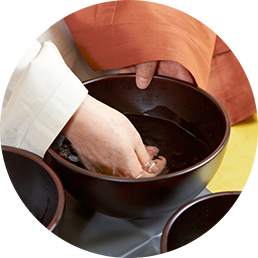 09.When the bamboo clapper is struck once, the assigned monks will pass the food in the following order: water, rice, soup, and assorted side dishes of vegetables and greens.
09.When the bamboo clapper is struck once, the assigned monks will pass the food in the following order: water, rice, soup, and assorted side dishes of vegetables and greens.
Rinse all the baru in the order of size with water that was initially served.
Save it in water-baru for later use. -
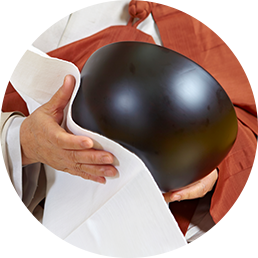 10.When the bamboo clapper is struck once again, hold and raise rice-baru high in the air with two hands and chant the “Meal Offering Verse."
10.When the bamboo clapper is struck once again, hold and raise rice-baru high in the air with two hands and chant the “Meal Offering Verse." -
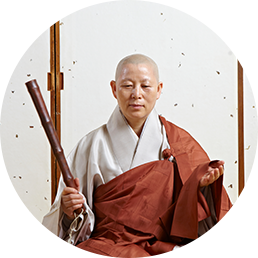 11.As a symbolic gesture of sharing food with all hungry beings, each monk sets aside a small portion of rice, which is gathered in a communal bowl.
11.As a symbolic gesture of sharing food with all hungry beings, each monk sets aside a small portion of rice, which is gathered in a communal bowl. -
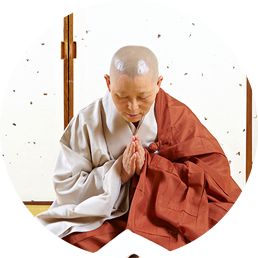 12.When the bamboo clapper is struck three times, eating finally begins.
12.When the bamboo clapper is struck three times, eating finally begins.
Practice harmonious eating by keeping pace with others and remain silent.
Leave a piece of kimchi to wipe any leftover food in the baru at the end.



